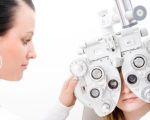- 1-Importance-of-Regular-Eye-Exams
- 2-Recommended-Frequency-of-Eye-Doctor-Visits
- 3-Factors-That-Influence-How-Often-to-See-an-Eye-Doctor
- 4-Signs-You-Should-See-an-Eye-Doctor-Sooner
- 5-How-Eye-Docs-Can-Help-Maintain-Your-Vision
1. Importance of Regular Eye Exams
Understanding how often you should see an eye doctor is crucial for maintaining long-term eye health. Regular eye exams not only help update your vision prescription but also detect early signs of eye diseases such as glaucoma, cataracts, and macular degeneration, which often have no symptoms in their early stages.
Early detection through routine exams can prevent vision loss and ensure timely treatment, making these visits a vital part of your overall healthcare.
Comprehensive Eye Health Monitoring
Eye exams go beyond testing visual acuity; they include checking eye pressure, retinal health, and overall eye function. This comprehensive approach supports early diagnosis of systemic conditions like diabetes and hypertension that impact eye health.
2. Recommended Frequency of Eye Doctor Visits
The ideal frequency for visiting an eye doctor varies depending on age, health status, and risk factors.
2.1 Adults Under 40
Generally, a full eye exam every two years is sufficient for healthy adults without vision problems.
2.2 Adults Over 40
After age 40, yearly exams are recommended as the risk for eye diseases increases.
2.3 Children and Teens
Regular exams are vital for children, especially before starting school and throughout their development, to detect and correct vision issues early.
3. Factors That Influence How Often to See an Eye Doctor
Individual health conditions and lifestyle can affect the recommended exam frequency.
3.1 Family History of Eye Diseases
A family history of glaucoma or macular degeneration may necessitate more frequent visits.
3.2 Existing Medical Conditions
Diabetes, high blood pressure, and autoimmune diseases often require closer monitoring of eye health.
3.3 Vision Correction Needs
Those with changing prescriptions or contact lens users may need more frequent checkups.
4. Signs You Should See an Eye Doctor Sooner
If you experience any of the following, it’s important not to delay an eye exam:
4.1 Sudden Vision Changes
Blurred vision, double vision, or sudden loss of sight require immediate attention.
4.2 Eye Pain or Discomfort
Persistent pain, redness, or discharge may indicate infections or other serious issues.
4.3 Frequent Headaches or Eye Strain
These symptoms can suggest underlying vision problems needing correction.
5. How Eye Docs Can Help Maintain Your Vision
Eye Docs provide expert care tailored to your unique needs, offering comprehensive exams, advanced diagnostics, and personalized treatment plans. Whether updating prescriptions, managing chronic conditions, or providing preventative advice, their expertise helps protect and enhance your vision over time.
For professional eye care and guidance on how often you should see an eye doctor, consult with Eye Docs. They combine cutting-edge technology with compassionate care to support your lifelong eye health.








